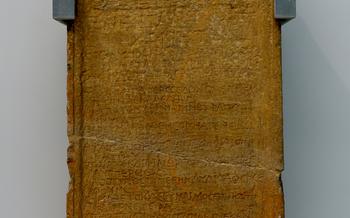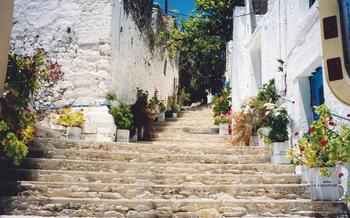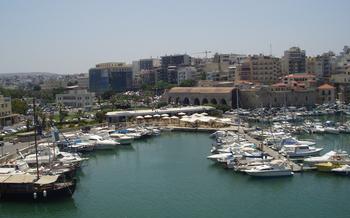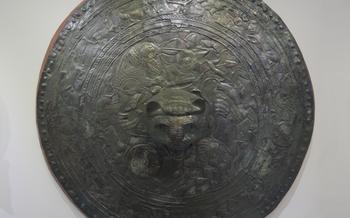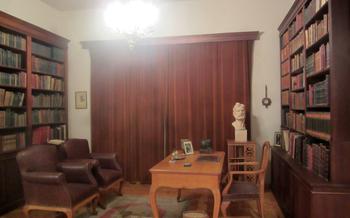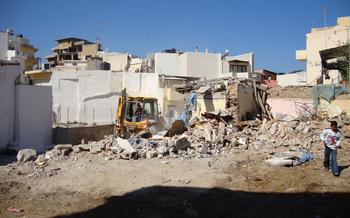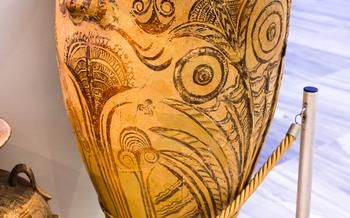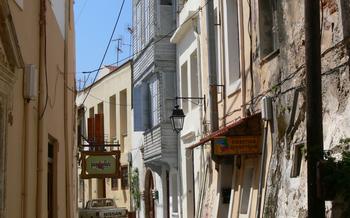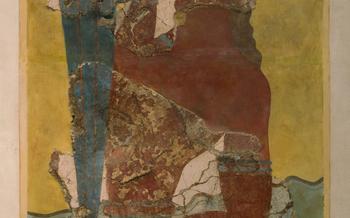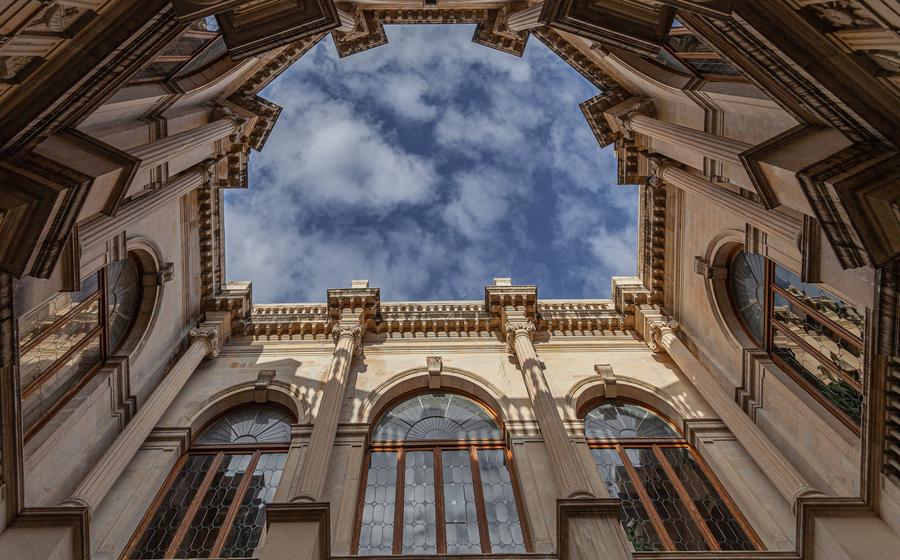
Tylissos Archaeological Site
- Tylissos Archaeological Site: An Overview
- Exploring the Minoan Palace of Tylissos
- The Royal Villa of Tylissos
- The Cemetery of Tylissos
- The Museum of Tylissos
- Planning Your Visit to Tylissos
- Getting to Tylissos
- Where to Stay in Tylissos
- Where to Eat in Tylissos
- Things to Do Near Tylissos
- Interesting Facts About Tylissos
- Tylissos for Families
- Insider Tip
Tylissos Archaeological Site: An Overview
The Tylissos Archaeological Site, located just a short drive from the city of Heraklion on the island of Crete, offers a fascinating glimpse into the rich history and culture of Minoan civilization. With its well-preserved palace, royal villa, cemetery, and museum, Tylissos provides visitors with an immersive experience of Minoan life and customs.
The site's history dates back to the Bronze Age, when Tylissos was a thriving city-state. The Minoan palace, built around 1700 BC, served as the administrative and ceremonial center of the city. The palace complex, with its impressive architectural features and exquisite frescoes, is a testament to the artistic and engineering achievements of the Minoans.
Tylissos was also home to a royal villa, located a short distance from the palace. The villa, with its luxurious amenities and stunning views of the surrounding countryside, was likely used by the city's rulers for relaxation and entertainment.
The site also includes a cemetery, where archaeologists have uncovered a variety of burials, including chamber tombs, pithos burials, and larnax burials. The grave goods and artifacts found in these burials provide valuable insights into Minoan burial customs and religious beliefs.
To learn more about the history and culture of Tylissos, visitors can explore the on-site museum, which houses a collection of artifacts discovered during excavations at the site. The museum's exhibits offer a comprehensive overview of Minoan life, from their daily activities to their religious practices.
Exploring the Minoan Palace of Tylissos
The Minoan Palace of Tylissos, a captivating vestige of the Bronze Age, stands as a testament to the architectural prowess and cultural achievements of the Minoan civilization. Built around 1700 BC, the palace served as the political and administrative center of the region, offering a glimpse into the sophisticated urban planning and societal organization of the Minoans.
The palace's layout is a marvel of ancient architecture, showcasing a central courtyard surrounded by a complex arrangement of rooms, storerooms, and workshops. These spaces were intricately interconnected by a network of corridors and stairways, facilitating efficient movement and communication within the palace complex.
Among the most remarkable features of the palace are the exquisite frescoes that once adorned its walls. These vibrant and lifelike paintings depicted scenes from Minoan mythology, religious ceremonies, and everyday life, providing valuable insights into the beliefs, customs, and artistic sensibilities of this ancient civilization.
The palace's grandeur is further enhanced by the presence of a grand staircase, leading to an upper floor that may have served as the royal living quarters. This staircase is a testament to the engineering skills of the Minoans, demonstrating their ability to construct complex architectural features with precision and stability.
The exploration of the Minoan Palace of Tylissos is a journey through time, allowing visitors to connect with the vibrant spirit of an ancient civilization. As you wander through its corridors and chambers, you can almost hear the echoes of footsteps, the hum of daily activities, and the whispers of a civilization that left an indelible mark on the history of Crete.
The Royal Villa of Tylissos
The Royal Villa of Tylissos is an impressive structure located within the archaeological site. It is believed to have been built during the Late Minoan period (1600-1450 BC) and served as a luxurious residence for the local ruler or an important official.
The villa is distinguished by its grand architecture and elaborate design. It features a central courtyard surrounded by several rooms and chambers. The walls of the villa are adorned with colorful frescoes depicting various scenes from Minoan life, including religious ceremonies, hunting expeditions, and everyday activities. These frescoes provide valuable insights into the artistic and cultural traditions of the Minoan civilization.
Excavations at the Royal Villa have unearthed a wealth of artifacts, including pottery, tools, and jewelry. These findings shed light on the daily life and activities of the villa's occupants. The villa also features a number of well-preserved storage rooms, which contained large quantities of agricultural products, indicating the economic importance of the site.
Overall, the Royal Villa of Tylissos offers a glimpse into the grandeur and opulence of Minoan society. It is a must-see for anyone interested in ancient history and archaeology.
The Cemetery of Tylissos
Unveiling Minoan Burial Customs
The cemetery of Tylissos is an integral part of the archaeological site, offering valuable insights into Minoan burial customs and beliefs. Located a short distance from the palace and the villa, the cemetery contains various types of burials, including simple pits, chamber tombs, and tholos tombs.
Archaeological excavations have revealed a wealth of grave goods and artifacts within the tombs, shedding light on the funerary practices of the Minoans. These include ceramic vessels, jewelry, tools, and weapons, providing clues about the social status and wealth of the deceased.
The presence of multiple burials within some tombs suggests a family or communal burial tradition. The careful placement of grave goods and the use of elaborate burial chambers indicate the importance placed on the afterlife by the Minoans.
The cemetery also offers a glimpse into the religious beliefs of the Minoans. The presence of figurines and other ritual objects suggests that the Minoans believed in a spiritual realm and an afterlife.
Exploring the cemetery of Tylissos is a fascinating journey into the mortuary practices and beliefs of the Minoan civilization, providing a deeper understanding of their cultural and spiritual values.
The Museum of Tylissos
The Museum of Tylissos is a treasure trove of artifacts and exhibits that shed light on the rich history and culture of Tylissos and the surrounding region. Established in the early 20th century, the museum houses a remarkable collection of Minoan artifacts discovered during excavations at the archaeological site.
Visitors to the museum can marvel at an array of pottery, tools, weapons, jewelry, and religious objects that provide a glimpse into the daily lives and beliefs of the Minoan people. Among the highlights of the collection are exquisite ceramic vessels with intricate designs, bronze tools and weapons that showcase the Minoans' advanced metalworking skills, and delicate jewelry made of gold, silver, and semi-precious stones.
The museum also features a collection of frescoes and other artwork that once adorned the walls of the Tylissos Palace and other Minoan buildings. These artworks depict scenes from everyday life, religious rituals, and mythical stories, offering valuable insights into Minoan society and culture.
In addition to its permanent collection, the Museum of Tylissos hosts temporary exhibitions and educational programs that delve deeper into various aspects of Minoan civilization. These exhibitions often feature new discoveries from ongoing archaeological excavations, providing visitors with a unique opportunity to learn about the latest research and developments in the field.
Planning Your Visit to Tylissos
Best time to visit
The best time to visit Tylissos is during the shoulder seasons (April-May and September-October) when the weather is mild and pleasant. Summer months (June-August) can be hot and crowded, especially during the midday hours. Winter months (November-March) can be cold and rainy, with limited opening hours at the archaeological site and museum.
Opening hours and admission fees
The Tylissos Archaeological Site and Museum are open to the public from Tuesday to Sunday, from 8:00 am to 3:00 pm. Admission fees are minimal, typically around 2-5 euros for adults and reduced rates for students and seniors.
Guided tours and other visitor services
Guided tours of the archaeological site and museum are available in English, Greek, and other languages upon request. Visitors can also rent audio guides or download a mobile app for a self-guided tour. The site provides basic amenities such as restrooms, a small gift shop, and a shaded area for picnicking.
Getting to Tylissos
Tylissos is situated about 20 kilometers southeast of Heraklion, the capital of Crete. The journey by car takes approximately 30 minutes, following the national road towards Arkalohori. There are also regular bus services from Heraklion to Tylissos, with buses departing from the central bus station (KTEL Heraklion) several times a day. The bus ride takes around 45 minutes.
Once you arrive in Tylissos, you can explore the archaeological site on foot. The main entrance to the site is located on the northern side, just off the main road. There is a small parking area near the entrance where you can leave your car.
Where to Stay in Tylissos
For those seeking a truly immersive experience, there are several accommodation options nestled near the archaeological site of Tylissos. Traditional guesthouses and charming hotels offer a glimpse into the local lifestyle and culture. Visitors can enjoy the warmth and hospitality of Cretan families while savoring delicious homemade meals and local delicacies.
A recommended hotel is the Tylissos Village Hotel. Overlooking the picturesque valley and the archaeological site, it offers comfortable rooms with stunning views. The hotel features a swimming pool, a traditional restaurant, and a welcoming atmosphere.
Alternatively, Villa Tylissos provides a unique experience in a restored 19th-century mansion. With its elegant rooms, private balconies, and lush gardens, it offers a tranquil retreat amidst the historical surroundings.
Whether seeking a rustic charm or a touch of luxury, Tylissos offers an array of accommodation options to suit every traveler's preference.
Where to Eat in Tylissos
For a taste of authentic Greek cuisine, head to one of the tavernas in Tylissos. These traditional restaurants offer a warm and welcoming atmosphere, with friendly service and delicious home-cooked meals. Many tavernas have outdoor seating areas, where you can enjoy your meal al fresco while taking in the views of the surrounding countryside.
Some of the must-try dishes in Tylissos include:
- Pastitsio: A hearty pasta dish made with layers of pasta, minced meat, and béchamel sauce.
- Souvlaki: Grilled skewers of meat, usually lamb or chicken, served with pita bread, tomatoes, onions, and tzatziki sauce.
- Moussaka: A casserole made with layers of eggplant, potatoes, minced meat, and béchamel sauce.
- Gemista: Stuffed tomatoes and peppers, filled with rice, herbs, and spices.
- Baklava: A sweet pastry made with layers of filo dough, filled with nuts and honey.
To accompany your meal, be sure to try some of the local wines from the Heraklion region. There are several wineries in the area, producing a variety of red, white, and rosé wines.
For a more casual dining experience, there are also a number of cafés and bakeries in Tylissos. These are great places to grab a quick bite to eat or a refreshing drink.
Things to Do Near Tylissos
Beyond the confines of the Tylissos Archaeological Site, the surrounding area offers a wealth of additional attractions and experiences for visitors. Other archaeological sites in the vicinity include the Minoan settlement of Knossos, the ancient city of Phaistos, and the Gortys Archaeological Park, each showcasing unique aspects of Crete's rich history.
The region is also blessed with stunning beaches and coastal attractions. Amoudara Beach, with its golden sands and crystal-clear waters, is just a short drive from Tylissos. For those seeking a more secluded experience, the picturesque beach of Agia Pelagia, known for its secluded coves and turquoise waters, is a must-visit.
Inland, the traditional villages of the region offer a glimpse into the authentic Cretan way of life. The village of Arolithos, with its narrow cobbled streets, whitewashed houses, and traditional tavernas, is a popular destination for visitors seeking a taste of local culture. The village of Kastelli, perched atop a hill with panoramic views of the surrounding countryside, is another highlight, renowned for its traditional crafts and pottery workshops.
Interesting Facts About Tylissos
-
Unique Features: Tylissos boasts several unique features that distinguish it from other Minoan sites. One notable characteristic is its well-preserved stone-paved streets, which provide a glimpse into the urban planning of the Minoan era. Another unique aspect is the presence of a "royal road", a wide, processional way that connected the palace to the cemetery.
-
Historical and Mythological Connections: Tylissos is steeped in history and mythology. It is believed to be the birthplace of Talos, a mythical bronze giant who guarded the island of Crete. According to legend, Talos was crafted by Hephaestus, the god of metalworking, and was programmed to protect Crete from invaders.
-
Local Legends and Folklore: Tylissos is a treasure trove of local legends and folklore. One popular tale tells of a hidden treasure buried beneath the ruins of the palace. According to legend, the treasure was hidden by the Minoans to protect it from invaders and is waiting to be discovered by a worthy adventurer.
Tylissos for Families
Tylissos offers a range of engaging and educational experiences for families with children. The archaeological site features interactive exhibits and activities designed to capture the imagination of young visitors. Families can embark on guided tours tailored to children's interests, where they can learn about Minoan history and culture in a fun and interactive way.
The Tylissos Museum also hosts family-friendly workshops and events throughout the year. These workshops provide hands-on opportunities for children to create their own Minoan-inspired art and crafts. The museum's knowledgeable staff is always available to answer questions and provide insights into the fascinating world of Minoan civilization.
In addition to the archaeological site and museum, Tylissos offers several outdoor spaces where families can relax and enjoy a picnic. The surrounding countryside provides ample opportunities for hiking and nature exploration. Children can discover the local flora and fauna, including a variety of wildflowers, herbs, and birds. The area is also a popular spot for birdwatching and wildlife photography.
With its engaging activities, educational programs, and beautiful natural surroundings, Tylissos is an ideal destination for families seeking a fun and enriching travel experience.
Insider Tip
For those seeking a truly unforgettable experience, venture off the beaten path to discover Tylissos' hidden gems. Stroll through the charming village, where time seems to stand still, and admire the traditional architecture and vibrant street art. Seek out the secluded cove just beyond the main beach, where you can bask in the sun's warmth and enjoy a refreshing dip in the crystal-clear waters. As the sun begins to set, find a secluded spot overlooking the valley and witness the sky transform into a canvas of vibrant colors. Whether you're a history buff, nature enthusiast, or simply seeking a unique adventure, Tylissos holds countless treasures waiting to be discovered. Embrace the spirit of exploration and let the magic of this ancient land captivate your senses.
